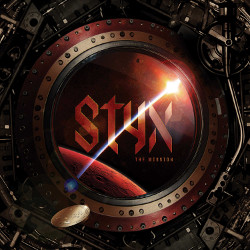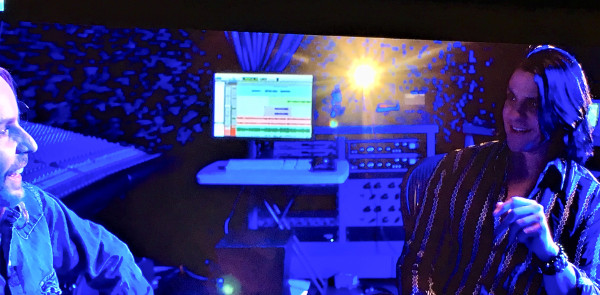Tommy Shaw on Mixing Styx’s ‘The Mission’ in 5.1

I was privileged to audition The Mission’s final full-channel form in Shaw’s home studio in Nashville a few months before the final album proper was released to the public last year. And I also hosted a panel with all three Mission mixmasters at the Hi-Res Audio Pavilion at CES 2018, wherein we chronicled the ins and outs of how the album’s 5.1 mix came together. Bottom line: The Mission is a shining example of how a great-sounding stereo record has even more impact in surround.
 A good bit of The Mission’s secret sonic sauce came from how it was recorded in the first place. “The best thing about working on this record was the spirit in how Tommy and Will wanted to make it,” Jim Scott told me. “Tommy said, ‘If we want to make it sound like 1979, how do we do that? Well, we perform it and we record it like it’s 1979.’ Creating the soundscapes and putting the extra music in between the songs was born out of studio fun. It wasn’t just hanging around with these guys and figuring out how to make outer space sounds without flying into outer space with microphones — it was pure fun. And that was the best part about it — not knowing the whole story until the whole thing revealed itself.”
A good bit of The Mission’s secret sonic sauce came from how it was recorded in the first place. “The best thing about working on this record was the spirit in how Tommy and Will wanted to make it,” Jim Scott told me. “Tommy said, ‘If we want to make it sound like 1979, how do we do that? Well, we perform it and we record it like it’s 1979.’ Creating the soundscapes and putting the extra music in between the songs was born out of studio fun. It wasn’t just hanging around with these guys and figuring out how to make outer space sounds without flying into outer space with microphones — it was pure fun. And that was the best part about it — not knowing the whole story until the whole thing revealed itself.”
With the Blu-ray version, you also get 62 minutes of behind-the-scenes “Making Of” documentary footage and three videoclips — not to mention a way-cool Visualizer option that you can select to run with or without the lyrics scrolling — for 162 minutes of total runtime. I’ve subsequently added one specific sequence from The Mission in 5.1 to my go-to list of benchmark reference tracks. Namely, it’s the furious, 38-second, six-channel maelstrom that occurs during a critical juncture in “Red Storm.” If you’re literally playing along at home, this sequence appears from 30:45 to 31:23 on your Blu-ray player’s readout. (More on the makings of this track below.)
Once the Blu-ray was released out into the world’s orbit, I conducted a pair of follow-up conversations with both Shaw and Evankovich to further delve into the making of the surround sound mix of The Mission, quantify each of their respective favorite 5.1 moments, and see what these masterful Mission 5.1 maestros might like to tackle in the format next. Now the red storm closing in — we can do this, let it begin . . .
Mike Mettler: Tommy, you first. Making the hardline decision to record The Mission with analog equipment only was a key choice for how the stereo and surround mixes ultimately came across, wouldn’t you agree?
Tommy Shaw: I totally agree, absolutely! During the writing process, Will and I discovered the songs had what we called a “new” vintage sound to them, so we just played around with the idea of making The Mission sound like our favorite-sounding Styx records of the past.
Mettler: You mean albums like The Grand Illusion (1977) and Pieces of Eight (1978)?
Shaw: Yes, both of those — but also Equinox (1975), the album Styx put out right before I joined the band. And, as you know, that era was totally analog, before CDs. We’ve gone through a few different phases since then, but our idea for The Mission was, “Let’s see if we can accomplish the same sound as if we were unearthing a lost record from 1979.” That was the idea we had in our heads the entire time.
The way we recorded everything was we used a lot of “old” technology with tubes in it, plus vintage microphones and EQs. Even in the demo and writing process, we tried to have things come across as analog-sounding as possible. By the time we were in the mixing phase, we realized just how dedicated Jim Scott was in making sure we stayed true to that idea. I can tell you from being there that there were no digital plug-ins used at any time.
There are lots of little areas where there were delays — especially in the 5.1 surround mix — but every delay you hear was done on a tape machine. We had a pair of separate reel-to-reel machines in the room, and any time we wanted that tape-delay sound, we counted on Jim to roll the tape machine and do the calculations for it — and he usually did them in his head. There’s a reason those delays have such a “lovely” sound to them, so if you’re wondering what is it that makes it sound that way — that’s tape saturation.
Mettler: Once you had the final Blu-ray in hand, you went and listened to the surround mix on Styx’s tour bus, right?
Shaw: I sure did, yes! I did that first listening session in the front lounge on the bus, and it was totally killer! (laughs) It sounded good in the back lounge, too. There was one time when we put it on that we knew something was off with it, but couldn’t quite figure out why. It was driving me crazy, so we just went to the back lounge, put it on in there, and got to enjoy all the nuances we knew were in that mix.

Well, we came to find out the speaker was just unplugged in the front lounge, so one day, I went and plugged it back in, and it was like (brief pause) . . . holy s---! It sounded better there than it did in my house! It took me a while to find the volume setting that was right, but when I did — oh man, did it sound good!
Mettler: I can totally relate to that feeling. Speaking of hearing something at the right volume, putting “Red Storm” on at full blast in the surround setting is one of my favorite moments of the record, and it’s one I’m now using as one of my critical reference tracks because of how good it envelops you as the listener.
Shaw: (nods) Yes! And I love when it all comes out of “Red Storm.” Before it goes into [the mostly instrumental track] “Khedive,” you get that “bling” sound that lets you know we’re still alive. Man, I wish we could just go back to that first day in the studio, when we were just playing Will’s rough mixes against the first half of Jim’s rough mixes, because that’s all we had — (slight pause) and it was all so good!
Mettler: You already know how much I personally feel hearing The Mission in 5.1 is the best way for any listener to truly get it.
Shaw: (nods enthusiastically) It’s the only way you get it. It’s a phenomenon.
But I do have to admit that it kills me whenever I hear from people who still haven’t listened to The Mission at all yet. I kinda get why because, these days, people just don’t expect great records. But when a good album like The Mission comes along, we hope something like the excitement of a 5.1 mix gets fans and listeners to go put it on and really get into it. I mean, when a record gets you like this one does and it grabs your attention when you least expect it, it pulls you in even further. And you’re surprised!
Mettler: It’s pretty satisfying to put The Mission on in surround and just sit back and, well,enjoy it for what it is.
Shaw: I need to sit down one time myself when I’m not being over-analytical and just enjoy it too! (both laugh) You know, I really enjoy turning up the volume and being rewarded for it, especially because I don’t want our music just being available as an MP3. This 5.1 mix of The Mission is living proof that it’s not just hope for the future, but that this is really happening now. If you want to be sitting in the catbird seat and really listen to what we’ve done, you can get it from the surround mix we approved. There’s now a platform for it, and there’s gear out there you can get to experience it in that way. I’m so glad about that. It sounds much better in 5.1, and you don’t have to settle for anything less. Man, I’m so glad that day is here.

Mettler: I’ll second that. Okay, Will, it’s your turn. You must be so happy to see The Mission finally get into the hands of fans of the 5.1 format, especially since you sweat a lot of blood over that mix for so long.
Will Evankovich: Absolutely. Jim Scott, Kevin Dean [assistant mixing engineer], and I had about a week of time where we really sat down and carved it all out — and we had so much fun doing it. We took a lot of chances you don’t typically get to do in 5.1.
Mettler: What kinds of chances are you talking about here? You mean, instead of taking either a “safe” approach or a “let me show off” approach, you all decided on going the “fully immersive” way instead?
Evankovich: Exactly. For lack of a better term, there are all these “vanilla” ways of doing it. But what’s great about working with Jim is that he is more (slight pause) — he is more experiential. His thought is, “What are we getting from this? Do we want vocals going above our heads, or do we want them going into the back speakers?” All of these rules didn’t apply. Some of the people already in the 5.1 world who heard our mix for the very first time were like, “What? You’re doing this? You’re doing that? That doesn’t make a lot of sense!” And we just said, “Well, we love it. But maybe we’re wrong. Maybe this mix is too bizarre.”
Mettler: Nah, I disagree with that. In my opinion, it’s a very interesting, very pioneering mix that you and Tommy Shaw were shooting for.
Evankovich: (laughs) Well, it is a journey for us, and it needs to be a 5.1 experience, because The Mission is not just a stereo experience. It needs to be a journey — it needs to be all around you, and it needs to be fun. It needs to be an experience that moves around where you need to close your eyes, and take the ride.
Mettler: You’re literally taking a trip into space. You need to feel like you, the listener, are on this Mission, and that you’re on the Khedive [space vessel]. You’re on the Mission right along with the crew. And when certain story beats change, the mix has to reflect that, as well as the changes the characters in the songs are going through themselves.
Evankovich: Absolutely.
Mettler: Do you have a personal favorite moment in the 5.1 mix?
Evankovich: Well, there were a lot of great moments that appear all throughout the mix. But one of the smaller things I really liked is, if you listen to the [album’s last] song “Mission to Mars,” it starts off in the back speakers, then it slowly creeps its way through the surrounds and on up into the front. And then the party starts, so to speak, when everything kind of explodes with the song. If you listen closely at the end, the spectrum of it all kind of goes back home, full circle.
Mettler: As if it went right back into orbit.
Evankovich: Yes, exactly — exactly! There were things like that that we did that became consciously a lot of fun. Some of the cool guitar solos, where they’re walking behind you in the back speakers, and moving around — we did a lot of panning for that. Maybe we did too much, I don’t know — but I love it. And so do Tommy [Shaw] and Jim [Scott].
Mettler: Oh, I do too. For me, something like “Red Storm,” which already has such power behind it, is a 5.1 marvel. Like I told Tommy, that one middle sequence — the one with all the crazy time signatures, full-on guitars, and totally insane drumwork from Todd [Sucherman] — is one I’m already using as a reference auditioning sequence.
Evankovich: (nods) It is a fun track. Even in stereo, there are a lot of things going on. In 5.1, we were able to part those things out, and really create the atmosphere on the surface of Mars.
Mettler: And, of course, I love the vintage synthesizer opening vibe of “Locomotive,” with its nod to a very specific Pink Floyd era. You guys captured their mid-1970s sound right there. I compared it with the sounds [Pink Floyd keyboardist] Rick Wright and [Pink Floyd bassist/vocalist] Roger Waters got from the EMS VCS 3, ARP, and Minimoog synths on “Welcome to the Machine,” which I listened to via the surround sound version of Wish You Were Here on SACD. You gotta hear that version for yourself someday, if you haven’t already.
Evankovich: I have not! I’ll have to listen to that at some point for sure!
[“Welcome to the Machine,” the second track on Pink Floyd’s pivotal 1975 classic Wish You Were Here that runs 7:31, is the textbook template for the opening to “Locomotive.” On “Welcome,” an EMS VCS 3 portable synthesizer was deployed by Rick Wright and Roger Waters to create a “throbbing” sound that was followed by a single-repeat echo originally made on bass by Waters. Wright also plays Hammond organ, an ARP string synthesizer, and a Minimoog monophonic analog synthesizer on the track, while David Gilmour plays both 6-string and 12-string acoustic guitars.]
Mettler: You’ll love it, without a doubt. The Mission is one of the first 5.1 mixes you’ve undertaken as a producer. Do you feel that level of experience helped you, or did it hinder you in any way?
Evankovich: My 5.1 mixing experience is limited, and I know it’s such an expansive world that so many other people have been involved in for many years. In one sense, we didn’t know exactly what the f--- we were doing, but Jim did, because he had done it before. But he was willing to go along with us and try anything, because he’s really a “try anything if it feels good” kind of guy, you know? He’s like, “Let’s go!”
We did a lot of stuff that was unconventional — not just the crazy stuff, but we also did things where we went, “We love it. It sounds good to us, so let’s keep it.” Maybe being inexperienced and stupid worked out in our favor, I don’t know! (both laugh heartily)
You’ve been an expert surround listener for many years, but as a relative newcomer to the world of 5.1, I was like, “If we’re going to do this, let’s just do everything we can to make it great, and make it exciting.” You just have to take chances.
Mettler: I totally agree with that. Now that the three of you — you, Jim, and Tommy, I mean — have made your mark with the 5.1 version of The Mission, how great would it be for you guys to do surround mixes for two of Styx’s most iconic ’70s albums, [1977’s] The Grand Illusion and [1978’s] Pieces of Eight, next?
Evankovich: Oh God — that’s the Holy Grail right there, isn’t it? We’d love to do both of them, no doubt. Unfortunately, we can’t do them right now because we still need to locate the original masters, but if we ever do (slight pause) — well, just make sure your ears are ready for what we have planned.
Mettler: You’ll just have more work to do, is all — so let’s go find those masters! (both laugh)
Evankovich: If I’m lucky enough to be involved in any of those things, that would be great. I’d be honored.
Mettler: In other words — if nominated, you will serve.
Evankovich: (laughs heartily) I’d be happy to. It would be another great journey for all of us to take together.
- Log in or register to post comments




































































